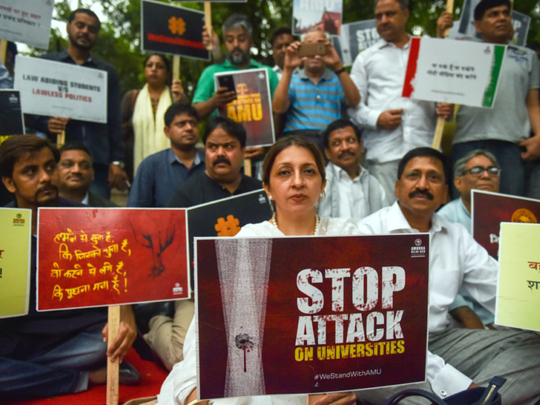
It’s no secret that the right-wing in India loves to loathe the country’s past. However, history is sacrosanct and it doesn’t change by dismantling a portrait or a piece of memorabilia, or by running a bulldozer on a statue.
Since the Bharatiya Janata Party (BJP) came to power at the Centre, it used a divisive tactic and focused on insignificant banter around Hindu-Muslim issues, ghar wapsi (homecoming), love jihad and nationalism to deflect attention from ‘core peoples issues’.
There have also been deliberate attempts to attack institutions that are progressive in thought. Recently, the right-wing started a campaign around a portrait of Muhammad Ali Jinnah, which hangs at the Aligarh Muslim University (AMU). The logic being conveyed is that anything to do with Pakistan is anti-national, which makes us all question the ‘sudden’ intent of the latest outrage. The portrait in question has been there since 1938 (hanging in the students’ union room). Students from the prestigious university aver that it was never about Jinnah’s portrait. The fact remains that the right-wing brigade had set its sights on AMU for a long time, and they needed an excuse to create a controversy. Jinnah’s portrait provided the perfect excuse. Now for some facts: The picture is installed in the students’ union room not for any symbolic reason, but for something that is historic. The portraits of all eminent life members of the university were installed there in 1938. No one can deny the fact that Jinnah was a part of undivided India’s legacy and a towering leader who fought shoulder to shoulder with Jawahar Lal Nehru for India’s independence.
The current controversy became big when scores of people, allegedly carrying weapons and saffron flags, tried to enter the AMU premises through its main gate. They were apparently ‘suddenly’ apprised over a portrait of Jinnah. A scuffle ensued between the right-wing rabble-rousers and security guards on AMU campus. While the ruckus was unfolding, Hamid Ansari, the former vice-president of India, was staying at a nearby guesthouse (inside the university campus).
While gory pictures of student leaders, bruised and bloody, emerged, what was truly appalling was that some right-wing extremists were being escorted by the local police. Within minutes, certain sections of the media started showing a completely contradictory version, whereby AMU was painted as a university housing anti-nationals and how it was part of a larger plan to “break India”. Hapless and unarmed students, with no means to defend their position, took to social media to share their side of the story.
Back to the controversy around the picture of Jinnah. Around the time (1938) when the portrait found its way inside the hallowed portals of the university, Jinnah was busy fighting for the cause of India’s independence from the British. The idea of Pakistan was nowhere in the reckoning in 1938. The British who ruled India for 200 years, reduced the country to penury, but left behind countless monuments, symbols and photographs of significance. Do we destroy all traces of the country’s evolution since independence?
Better sense prevails
Another pertinent observation that comes to mind is that Jinnah’s portrait is also on the walls of other institutions, such as the Indian Institute of Advanced Studies in Shimla and Bombay High Court. It is surprising that the right-wing has not visited these places in all these years to protest.
Nowhere in the civilised world does one pin a helpless student down while he’s unarmed and break his bones. Yet, that is what happened in AMU after the controversy erupted. Soon enough, social media was abuzz with claims that students from AMU were raising seditious slogans of “Azaadi” (freedom). Fortunately, better sense prevailed as some raised their voices against what was being played out.
We must not forget that AMU is a beacon of hope to many students in India who have no other means or resource to access higher education. Tarnishing its name for petty political gains will leave a generation of students in an abyss of darkness. While agencies and committees are set up to assess the socio-economic condition of Muslims in India, we must not forget that only education can get the community out of despair. Targeting minority institutions on trivial grounds could mar the future of the country.
Saira Shah Halim is an educator and a civil rights activist who is involved with causes such as gender equality and safeguarding democracy. She is the daughter of Lt General Zameeruddin Shah, former vice-chancellor of Aligarh Muslim University.








